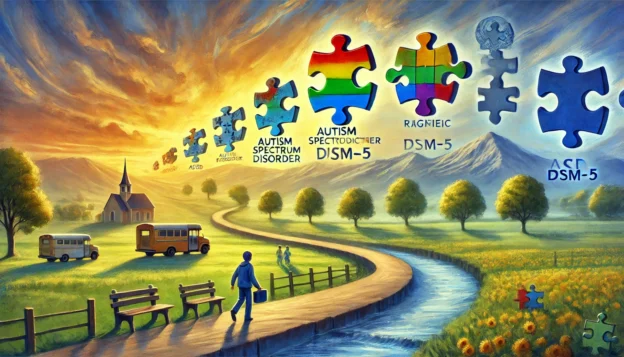Autism Spectrum Disorder (ASD) has undergone significant reclassification over time. Historically, it was divided into subtypes including Infantile Autism, Asperger’s Syndrome, Pervasive Developmental Disorder-Not Otherwise Specified (PDD-NOS), Childhood Disintegrative Disorder (CDD), and Rett Syndrome. These subtypes were recognized based on varying social, communicative, and behavioural challenges. In 2013, the DSM-5 unified these categories under a single diagnosis of ASD, reflecting a spectrum of symptoms with varying severity. This modern classification emphasizes persistent social communication deficits and restricted, repetitive behaviours, with levels indicating the required support. This shift enhances diagnostic consistency and personalized support for individuals with autism.
Introduction
Autism Spectrum Disorder (ASD) has evolved significantly in its classification over the years. Historically, various subtypes were recognized, but contemporary understanding has unified these under a single spectrum. Here’s an overview of the major categories of ASD, both historically and as understood today.
Historical Categories
- Infantile Autism
- Identified by Dr. Leo Kanner in 1943, this term described children with severe social withdrawal, a preference for sameness, and unique language use.
- Asperger’s Syndrome
- Described by Dr. Hans Asperger in 1944, this condition involved children with similar social challenges and restricted interests as those observed by Kanner but with average to above-average intelligence and better language skills.
- Pervasive Developmental Disorder-Not Otherwise Specified (PDD-NOS)
- Introduced in the DSM-III and refined in the DSM-IV, PDD-NOS was used for individuals who did not fully meet the criteria for other specific diagnoses but still displayed significant challenges in social and communicative behaviours.
- Childhood Disintegrative Disorder (CDD)
- Recognized in the DSM-IV, CDD was characterized by a significant loss of previously acquired skills (such as language and social abilities) after at least two years of normal development.
- Rett Syndrome
- Although now recognized as a distinct genetic condition rather than part of the autism spectrum, Rett Syndrome was once included in the DSM-IV as a pervasive developmental disorder. It primarily affects girls and is characterized by normal early development followed by a loss of motor and communication skills.
Modern Classification
With the publication of the DSM-5 in 2013, the understanding of ASD was streamlined into a single diagnosis:
- Autism Spectrum Disorder (ASD)
- The DSM-5 merged the previously separate categories into one umbrella diagnosis of Autism Spectrum Disorder. This reflects the recognition that autism exists on a spectrum with varying degrees of severity and manifestations. The criteria emphasize:
- Persistent deficits in social communication and social interaction across multiple contexts.
- Restricted, repetitive patterns of behaviour, interests, or activities.
- ASD is now described in terms of levels of support needed:
- Level 1: Requiring support
- Level 2: Requiring substantial support
- Level 3: Requiring very substantial support
- The DSM-5 merged the previously separate categories into one umbrella diagnosis of Autism Spectrum Disorder. This reflects the recognition that autism exists on a spectrum with varying degrees of severity and manifestations. The criteria emphasize:
Key Changes in Classification
- Consolidation: The DSM-5’s consolidation of subtypes into a single diagnosis was aimed at improving diagnostic consistency and recognizing the spectrum nature of autism.
- Focus on Spectrum: This change acknowledges that individuals with autism can have a wide range of abilities and challenges, allowing for a more personalized approach to diagnosis and support.
- Severity Levels: Introducing severity levels helps clinicians describe the specific support needs of individuals with ASD, facilitating better-tailored interventions and resources.
Conclusion
Historically, autism was divided into several distinct categories, reflecting the varied presentations of the condition. Today, the modern classification under the DSM-5 emphasizes the spectrum nature of autism, acknowledging the broad range of characteristics and support needs of individuals with ASD. This shift towards a unified diagnosis aims to enhance understanding, diagnosis, and support for people with autism across different levels of severity.
